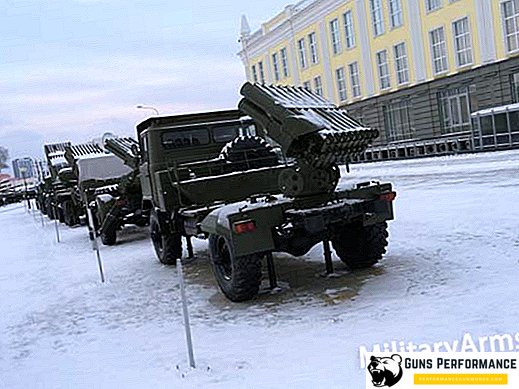Silent aliens from space - meteorites - arriving to us from the starry abyss and falling to Earth, can be of any size, starting with small pebbles, ending with blocks of gigantic size. The consequences of such falls are different. Some meteorites leave behind vivid memories in our memory and a faint trace on the surface of the planet. Others, on the contrary, falling on our planet, entail disastrous consequences.
The places of the fall of the largest meteorites in the history of the Earth vividly testify to the true size of the uninvited guests. The surface of the planet has retained huge craters and destructions left after a meeting with meteorites, which indicates the possible destructive consequences that humankind is expecting if a large-sized space body falls to Earth.
Meteorites falling on our planet
Space is not as deserted as it seems at first glance. Scientists estimate that 5-6 tons of space material crashes on our planet every day. For the year, this figure is about 2000 tons. This process takes place constantly, over billions of years. Our planet is constantly attacked by dozens of meteor showers, in addition, from time to time asteroids can fly to Earth, zipping from it in dangerous proximity.

Each of us can witness the fall of a meteorite at any time. Some fall in our sight. In this case, the fall is accompanied by a whole series of bright and memorable phenomena. Other meteorites that we do not see fall in an unknown place. We learn about their existence only after we find fragments of material of extraterrestrial origin in the course of our life activity. In view of this, it is customary to divide cosmic gifts that arrived to us at different times into two types:
- fallen meteorites;
- found meteorites.
Each fallen meteorite, whose flight was predictable, receives a name before falling. Found meteorites are called mainly at the place of their findings.
Information on how meteorites fell and what consequences there were at the same time is extremely limited. The scientific community only in the middle of the XIX century began to track the fall of meteorites. The entire previous period in the history of mankind contains very few facts about the fall of large celestial bodies on Earth. Such cases in the history of various civilizations are more likely mythological in nature, and their description has nothing to do with scientific facts. In the modern era, scientists began to study the results of the fall of meteorites closest in time to us.

A huge role in the process of studying these astronomical phenomena is played by meteorites found on the surface of our planet in a later period. Today, a detailed map of the fall of meteorites has been compiled, areas of the most likely meteorite fall in the future are indicated.
Nature and behavior of falling meteorites
Most of the heavenly guests who visited our planet at different times are stone, iron, and combined meteorites (iron-stone). The former are the most frequent occurrences in nature. These are residual fragments from which the planets of the solar system were formed. Iron meteorites consist of iron of natural origin and nickel, and the share of iron in them is more than 90%. The number of iron space guests who have reached the surface layer of the earth's crust does not exceed 5-6% of the total.

Goba is by far the largest meteorite found on Earth. A huge lump of extraterrestrial origin, an iron giant weighing 60 tons, fell to Earth in prehistoric times, and was only found in 1920. About this space object today became known only because it consists of iron.
Stone meteorites are not as strong formations, but they can also reach large sizes. Most often, such bodies collapse during flight and on contact with the ground, leaving behind huge craters and craters. Sometimes a stone meteorite collapses during flight through the dense layers of the Earth’s atmosphere, causing a massive explosion.
This phenomenon is still fresh in the memory of the academic community. The collision of planet Earth in 1908 with an unknown celestial body was accompanied by an explosion of tremendous force that occurred at a height of about ten kilometers. This event occurred in Eastern Siberia, in the basin of the Podkamennaya Tunguska River. According to the calculations of astrophysicists, the explosion of the Tunguska meteorite of 1908 had a power of 10-40 Mt in terms of the TNT equivalent. In this case, the shock wave circled the globe four times. Within a few days, strange phenomena occurred in the sky from the Atlantic to the Far East. It is more correct to call this object a Tungus meteoid, since the cosmic body exploded above the surface of the planet. Studies of the explosion area, which has been going on for more than 100 years, have given scientists a huge amount of unique scientific and applied material. The explosion of such a large celestial body, weighing hundreds of tons in the area of the Siberian river Podkamennaya Tunguska, is called the Tunguska phenomenon in the scientific world. To date, more than 2 thousand fragments of the Tunguska meteorite have been found.

Another space giant left behind a huge crater, Chicxulub, located on the Yucatan Peninsula (Mexico). The diameter of this giant depression is 180 km. The meteorite, which left behind such a huge crater, could have a mass of several hundred tons. Not without reason, scientists consider this meteorite the largest of all those who have visited the Earth in its entire long history. No less impressive is the trail from the fall of a meteorite in the United States, the world-famous Arizona crater. Perhaps the fall of such a huge meteorite was the beginning of the end of the dinosaur era.

Such destruction and such large-scale consequences are the result of the tremendous speed that a meteorite rushing towards Earth has, its mass and size. The falling meteorite, whose speed is 10-20 kilometers per second, and the mass - tens of tons, is capable of causing tremendous destruction and casualties.
Even not so large space guests, flying to us, can cause local destruction and cause panic among the civilian population. In the new era, humanity has repeatedly come across such astronomical phenomena. In fact, everything except panic and excitement was limited to curious astronomical observations and the subsequent study of the places where meteorites fell. So it was in 2012 during the visit and the subsequent fall of the meteorite with the beautiful name Sutter Mill, which, according to preliminary data, was ready to shred the territory of the United States and Canada. Immediately in several states, residents observed a bright flash in the sky. The subsequent flight of the car was limited to the fall on the earth's surface of a large number of small fragments scattered over a vast territory. The meteor shower in China, observed around the world in February 2012, passed in a similar way. In the desert regions of China, up to hundreds of meteorite stones of various sizes have fallen, leaving holes and funnels of various sizes after the collision. The mass of the largest fragment found by Chinese scientists was 12 kg.

Such astrophysical phenomena occur regularly. This is due to the fact that the meteor showers rushing in our solar system, from time to time can cross the orbit of our planet. A vivid example of such meetings are regular visits of the Earth to the Leonid meteor shower. Among the famous meteor showers, it is with Leonids that the Earth is forced to meet every 33 years. During this period, which falls on the month of November, the star-fall is accompanied by falling debris on the Earth.
Our time and new facts about fallen meteorites
The second half of the 20th century was for astrophysicists and geologists a real test and experimental testing ground. During this time, quite a lot of meteorite falls occurred, which were recorded in various ways. Some of the heavenly guests with their appearance created a furor among scientists and caused a considerable agiotage among the townsfolk, other meteorites became just another statistical fact.

Human civilization continues to drive incredibly. The largest meteorites that have fallen to Earth in the modern era have not been of enormous size, nor have they seriously damaged the infrastructure. Space aliens continue to fall in sparsely populated areas of the planet, showering part of the wreckage. Cases of falling meteorites, entailing victims, are practically absent in the official statistics. The only facts of such an unpleasant acquaintance are the fall of a meteorite in Alabama in 1954 and the visit of a space guest to the UK in 2004.

All other cases of the Earth’s collision with celestial objects can be characterized as an interesting astronomical phenomenon. The most famous facts of the fall of meteorites can be counted on the fingers. There are a lot of documentary evidence about these phenomena and a lot of scientific work has been done:
- Kirin meteorite, whose mass is 1.7 tons, fell in March 1976 in the northeastern part of China during a meteor shower that lasted 37 minutes and covered the entire northeastern part of the country;
- in 1990, near the town of Sterlitamak on May night from 17 to 18, a meteorite rock weighing 300 kg fell. Heavenly guest left behind a crater with a diameter of 10 meters;
- In 1998, a 800-kg meteorite fell in Turkmenistan.
The beginning of the third millennium was marked by a number of bright astronomical phenomena, among which the following should be noted:
- September 2002 was marked by a monstrous air blast in the region of Irkutsk, which was the result of the fall of a huge meteorite;
- a meteorite that fell on September 15, 2007 near Lake Titicaca. This meteorite fell in Peru, leaving behind a funnel 6 meters deep. Fragments of this Peruvian meteorite found by local residents measured in the range of 5–15 cm.

In Russia, the most striking case is associated with the flight and the subsequent fall of the heavenly guest near the city of Chelyabinsk. On the morning of February 13, 2013, news swept the country: a meteorite fell in the area of Lake Chebarkul (Chelyabinsk Region). The main force of the impact of the cosmic body experienced the surface of the lake, from which fragments of a meteorite with a total weight of more than half a ton were subsequently caught from a depth of 12 meters. A year later, the largest fragment of the Chebarkul meteorite, weighing several tons, was caught from the bottom of the lake. At the time of the flight of the meteorite, it was observed by residents of three regions of the country at once. Over the Sverdlovsk and Tyumen regions, eyewitnesses observed a huge fireball. In Chelyabinsk itself, the fall was accompanied by insignificant damage to urban infrastructure, but injuries occurred among the civilian population.

Finally
How many more falls on our planet meteorites, it is impossible to say for sure. Scientists are constantly working in the field of anti-meteorite security. An analysis of recent developments in this area has shown that the intensity of space visits by space guests has increased. Forecasting falls in the future is one of the main programs, which is carried out by experts from NASA, other space agencies and scientific astrophysical laboratories. Still, our planet remains poorly protected from the visits of uninvited guests, and a large meteorite that fell on Earth can do its job - to put an end to our civilization.












